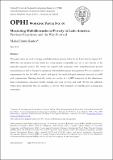| dc.contributor.author | Santos, Maria Emma | en |
| dc.coverage.spatial | Latin America | en |
| dc.coverage.spatial | Latin America | |
| dc.date.accessioned | 2016-06-23T14:42:10Z | |
| dc.date.available | 2016-06-23T14:42:10Z | |
| dc.date.issued | 2014 | en |
| dc.identifier.citation | Santos, M. E. (2014) Measuring Multidimensional Poverty in Latin America: Previous Experience and the Way Forward. OPHI Working Papers 66, Oxford: University of Oxford. | en |
| dc.identifier.isbn | 9781907194535 | |
| dc.identifier.uri | https://opendocs.ids.ac.uk/opendocs/handle/20.500.12413/11822 | |
| dc.description.abstract | This paper states the need to design a multidimensional poverty index for the Latin America region (LA-MPI) that can monitor poverty trends in a cross-country comparable way, yet is also relevant to the particular regional context. We review the region’s rich experience with multidimensional poverty measurement, as well as Europe’s experiences with multidimensional measurement. We set a number of requirements for the LA-MPI to satisfy and specify the methodological criterions necessary to fulfill such requirements. Drawing from the review, we outline an LA-MPI composed of five dimensions: basic consumptions, education, health, housing and basic services, and work. We list the indicators within those dimensions that are desirable, as well as what indicators are feasible given existing data constraints. | en |
| dc.language.iso | en | en |
| dc.relation.ispartofseries | OPHI Working Papers 66 | en |
| dc.rights | | |
| dc.rights.uri | http://creativecommons.org/licenses/by-nc-nd/4.0/ | en |
| dc.title | Measuring Multidimensional Poverty in Latin America: Previous Experience and the Way Forward | en |
| dc.type | Series paper (non-IDS) | en |
| dc.rights.holder | Oxford Poverty & Human Development Initiative | |
| dc.identifier.externaluri | https://doi.org/10.35648/20.500.12413/11781/ii040 | |
| dc.identifier.ag | RES-167-25-0617, ES/I032827/1 | en |
| dc.identifier.doi | 10.35648/20.500.12413/11781/ii040 | |


